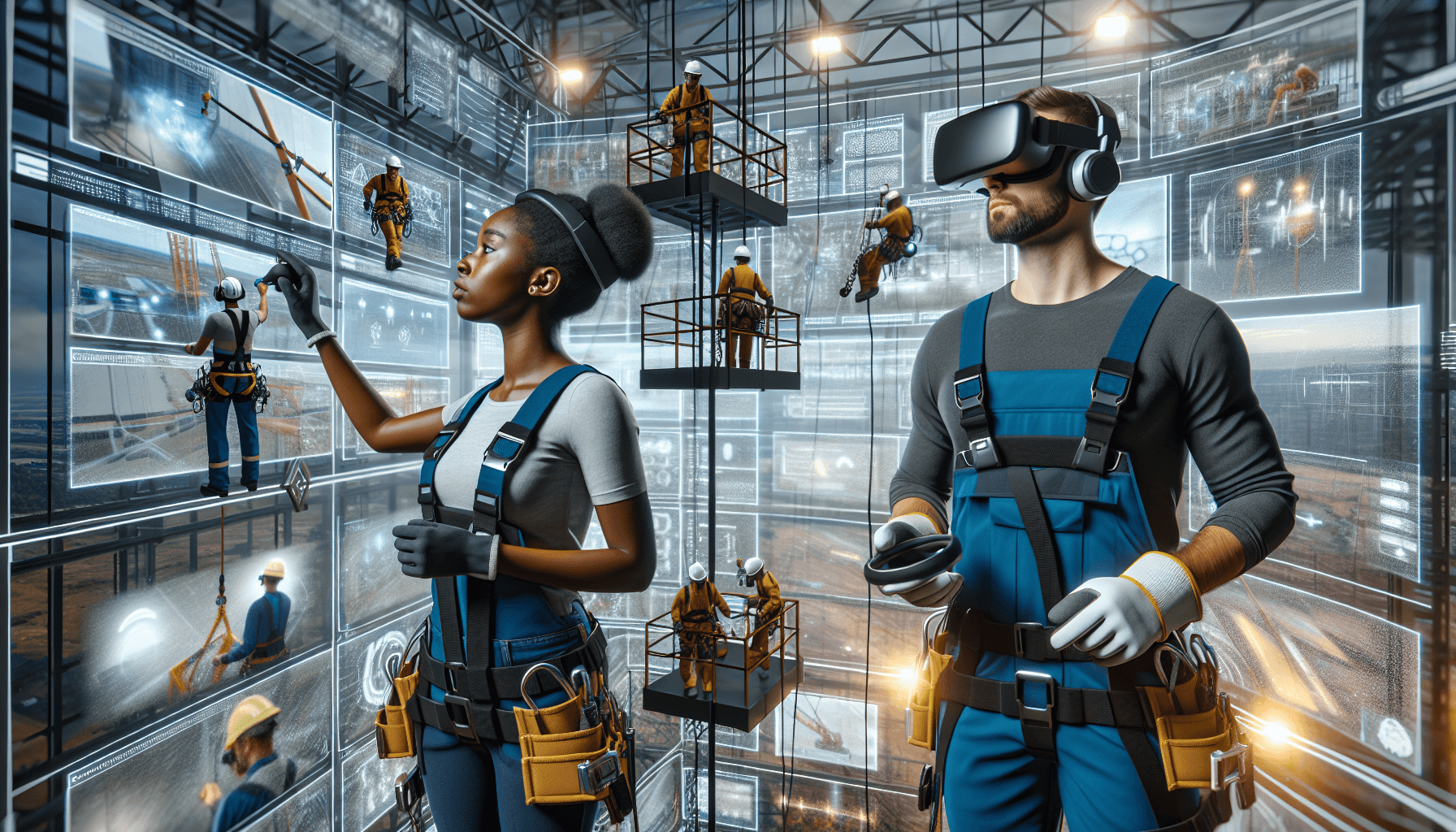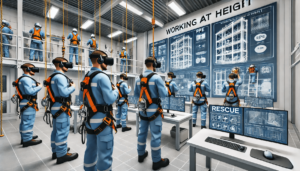In the realm of industrial safety training, the adoption of working at heights VR technology is revolutionizing how organizations prepare their personnel for the unique challenges of elevated work environments. The essential nature of comprehensive safety training cannot be overstated—particularly when it pertains to fall prevention, the use of fall protection systems, and navigating elevated work platforms. These scenarios, filled with potential hazards, demand not only theoretical knowledge but the practical ability to apply safety measures under pressure. Virtual reality safety training offers an immersive simulation experience that bridges the gap between traditional learning methods and the real-world demands of work at height safety.
This article delves into the critical aspects of why VR headsets are becoming an indispensable tool in safety training programs aimed at working at heights. It highlights how immersive simulations facilitate a deeper understanding of fall prevention measures and the operation of fall protection systems, thereby enhancing the overall safety awareness and preparedness of workers.
Key features of working at height VR modules will be explored, showing their advantages over conventional training methodologies—including how they offer realistic, hands-on practice without the risks associated with actual elevated work. Furthermore, we will explore the tangible benefits of VR workplace training, not only in terms of improved safety outcomes but also regarding efficiency and engagement in training processes, setting the stage for a comprehensive exploration of the subject matter.
The Importance of Safety Training for Working at Heights
Overview of Risks Involved
Working at heights is an inherent part of many construction and maintenance jobs, where daily tasks may involve climbing ladders, scaffolding, or using harness and pulley systems for roof sheeting or window cleaning. These activities, while necessary, present significant risks ranging from minor injuries to fatalities. The stark reality is highlighted by statistics showing that nearly one-third of fatal accidents on construction sites are due to falls from height. Additionally, other hazards such as falling objects and unstable surfaces contribute to the dangers, emphasizing the critical need for comprehensive working at heights safety training.
Traditional Training Methods and Their Drawbacks
Traditional training methods often rely heavily on theoretical knowledge, which, while fundamental, may not fully prepare workers for the practical challenges encountered in real-world scenarios. For instance, conventional training might involve classroom-based learning that lacks the hands-on experience necessary for workers to react effectively in high-risk situations. This gap in training can lead to improper use of safety equipment or failure to adhere to safety procedures, further increasing the risk of accidents.
Moreover, the traditional approach may not adequately address the varied and complex nature of tasks performed at height, where different safety skills and safety competence are required depending on the specific job. The limitations of traditional training highlight the importance of adopting more dynamic and interactive methods, such as vr training construction, to enhance the overall effectiveness of safety training programs.
How VR Technology Enhances Safety Training
Immersive Experience
Virtual Reality (VR) technology offers a highly immersive experience that places trainees inside a simulated environment, which can be either a realistic representation of the workplace or a controlled, fantastical setting. This immersion is achieved through advanced technologies like head-mounted displays, motion tracking sensors, and haptic feedback devices, which together create a sense of presence and engagement. Trainees feel as if they are interacting with the environment in a tangible way, which is crucial for effective learning and retention. Studies have shown that such immersive training can lead to significantly higher retention rates, with one study revealing a 75% retention rate for VR training compared to only 10% through traditional reading or lectures. Virtual reality training software is designed to maximize this immersive experience.
Realistic Simulation of Hazardous Scenarios
VR technology excels in simulating hazardous work environments safely and effectively. For industries where real-life training carries significant risks, such as oil and gas or construction, VR provides a safe platform for practicing responses to emergency situations without the real-world dangers. These height simulations can replicate complex scenarios involving elevated work platforms, hazardous material handling, or emergency evacuations, providing hands-on experience that traditional methods cannot. By allowing trainees to make mistakes and learn from them in a risk-free setting, VR not only enhances safety but also boosts confidence in handling real situations. This approach not only improves safety outcomes but also reduces training costs by minimizing the need for physical resources and reducing the risk of accidents during training.
Key Features of Working at Height VR Modules
Personal Protective Equipment (PPE) Usage
In virtual reality construction safety training, trainees are immersed in realistic environments where they must select and utilize the correct personal protective equipment (PPE). This training is critical as it allows them to experience the consequences of their choices, such as selecting inappropriate fall protection gear which can lead to simulated accidents. This hands-on approach not only enhances understanding but also improves the retention of safety regulations, ensuring that employees are less likely to make similar mistakes in real scenarios.
Rescue Operations
Virtual reality modules designed for rescue operations provide workers with the skills needed to perform safe and effective rescues at height. Trainees practice in high-pressure virtual scenarios where quick decision-making and proper equipment usage are crucial. These safety simulation training exercises are vital for preparing workers to handle emergency situations, ensuring the safety of all individuals involved.
Fall Protection Measures
VR training modules focus extensively on fall protection measures. Workers learn to identify potential fall hazards, assess safe fall distances, and apply correct fall arrest techniques through immersive simulations. This training is essential in educating workers on the use of harnesses, lanyards, and anchor points, which are critical components in preventing falls. The realistic, simulated environments allow trainees to experience and learn from potential errors in a controlled setting, thereby emphasizing the importance of prevention and proper usage of fall protection systems. Height simulator vr technology is particularly effective for this type of training.
Advantages of VR Over Traditional Training Methods
Reduced Risk of Actual Harm
Virtual reality (VR) training provides a safe environment where trainees can engage in realistic and immersive scenarios without the risk of actual harm. This aspect is particularly crucial in industries like construction, where working at height involves significant risks. VR allows trainees to experience dangerous situations, such as standing on a high scaffold or navigating a burning building, in a controlled setting where they can learn to react appropriately without the fear of real-world consequences. Virtual reality safety training software is designed to maximize risk mitigation while providing an effective learning experience.
Higher Retention of Safety Protocols
Studies have demonstrated that VR training significantly enhances the retention of safety protocols among trainees. This increased retention is attributed to the immersive and interactive nature of the training, which stimulates multiple senses and creates a more memorable learning experience. Trainees are more likely to remember and apply what they have learned when the training environment mimics real-life situations closely. For instance, the ability to repeatedly practice the correct use of personal protective equipment in a VR setting leads to better performance in actual work scenarios, as VR health and safety training is designed to maximize retention and application of safety protocols.
Cost-effectiveness
While the initial setup costs for VR training systems can be considerable, the long-term savings and return on investment are considerable. VR training reduces the need for physical resources, such as equipment and space, and minimizes the risks of costly accidents during training. Additionally, the efficiency of VR training means that sessions can be completed in a shorter time compared to traditional methods, thereby reducing the downtime of employees and allowing them to return to productive work sooner. The ability to use the VR content repeatedly for different training needs across the organization further adds to its cost-effectiveness. Virtual reality in construction safety training is a cost-effective solution in the long run.
Conclusion
Throughout the exploration of this article, it becomes evident that the integration of VR technology in safety training, especially in the context of working at heights, is not just an innovative approach but a necessary evolution. The immersive nature of VR training modules provides workers with unparalleled practical experience, safely exposing them to the realities and potential dangers of elevated work environments. By simulating realistic scenarios, VR technology has been shown to considerably enhance the retention of safety protocols and procedures, preparing employees more thoroughly for the challenges they face daily. This preparation is key to minimizing risks and ensuring the safety and well-being of all involved, ultimately contributing to a safer, more efficient workplace and a stronger safety culture.
Reflecting on the broader implications, it’s clear that adopting VR for working at heights training carries significant advantages over traditional methods, including reduced risks of accidents during training, improved engagement and knowledge retention among employees, and potential cost savings for organizations. As industries continue to evolve and seek safer, more effective training solutions, VR stands out as a critical tool in enhancing workplace safety cultures. The call to action is clear: for industries reliant on working at heights, investing in VR technology for safety training is not just beneficial; it’s essential for future-proofing safety protocols and nurturing a culture of safety first. This embrace of technology in safety training paves the way for a future where on-the-job accidents become increasingly rare, underscoring the vital role of innovation in industrial safety training.
FAQs
What advantages does VR offer in safety training?
Virtual Reality (VR) technology crafts immersive simulated environments, allowing trainees to undergo highly realistic scenarios and hone their reactions and skills safely, without the risks associated with real-life training. The depth of physical and mental engagement provided by such immersive training can significantly impact trainees’ proficiency. Height simulator technology is a prime example of how VR can enhance safety training.
How does VR training benefit companies and employees?
VR training is crucial for companies as it allows employees to practice essential job skills within a safe, controlled, and realistic environment. This not only prevents risks to the trainees and others but also enhances situational and spatial awareness, leading to safer workplace practices, fewer accidents, and ultimately, lower costs. Ladder safety training, for example, can be effectively conducted using VR technology.
What role does virtual reality play in construction safety training?
In the construction industry, VR is utilized to deliver immersive simulations specifically tailored for safety and hard skills training. This method is highly effective and complies with Occupational Safety and Health Administration (OSHA) requirements, ensuring that workers receive thorough and compliant safety training. Working at heights course online and online working at height course are examples of how VR is being used in construction safety training.
Why are VR simulations critical for training purposes?
VR simulations are integral to training because they provide advanced reporting tools that track trainee performance over time and support effective debriefing sessions. These tools can highlight both correctly and incorrectly performed actions, with detailed timestamps for each action within.


